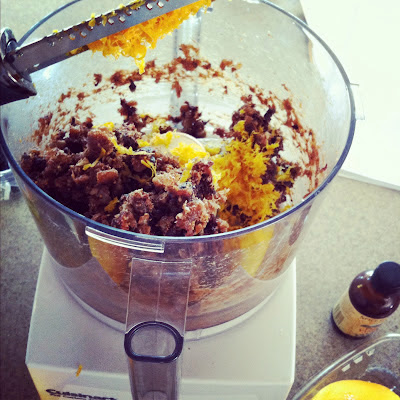I'll admit, I've been sneaking brownies at work. Chocolate chip cookies too. I don't know why this sweet tooth is hanging around so long, but I had to do something about it. So I jazzed up my protein bar recipe with CHOCOLATE! With the right ingredients, I even made them VEGAN. Now, I can feed my chocolate craving, guilt free, and get my protein too!
If you saw my last entry, I'm focusing on protein this week. Follow this recipe, and each bar packs about 6g of soy-free protein! Their great in the morning to accompany a smoothie, easy to grab on the go, and make for a great little snack between meals, or before or after your workout.
Power (brownie) Bars
Ingredients:
- 6 oz dried pitted dates, chopped
- 6 oz dried black figs, chopped
- 1 cup raw almonds, chopped
- 1/3 cup hemp seeds
- 1 cup almond butter
- 1/2 tsp. cinnamon
- zest of two oranges
- 1 tsp. vanilla extract
- 6-8 ounces of chocolate protein powder (I recommend Vega One)
- 1 1/2 cup espresso - brewed and chilled
- 1/2 cup mini vegan chocolate chips (I used Enjoy Life, so yummy)
Optional Ingredients:
There's a lot of room in this recipe to be creative, add 1/3 cup of walnuts, or some shredded coconut if you like. I encourage you to add your personal touch so these become something you crave.Equipment:
- 8x11 brownie pan
- A food processor is highly recommended. The first time I ever made 'power bars,' I chopped all my dates and figs by hand. It was ridiculously laborious, and very sticky. To make these today, I borrowed my sister's.
Step 1.
Brew 2 cups of strong espresso, and set aside to cool.
Step 2.
In a food processor, combine figs and dates. Depending on how good your machine is, you may want to do a little pre-chopping. I just threw the whole fruits right in there, but add only a few at a time as you pulse the blade, so as not to overheat the machine.
Step 3.
Add the next 5 ingredients, and anything else you want, like toasted coconut flakes, dried cherries, or even puffed rice cereal. Pulse the machine until this resembles a dry dough. It may seam a little flakey, or stickey, but don't worry, we're going to add moisture.
Step 4.
In a mixing bowl, slowly add 1-2 cups of the cooled espresso to your chocolate protein powder, and whisk until no lumps remain. This should resemble brownie batter, which is what gave me the thought that these remind me of brownies.
Step 5.
In a large mixing bowl, combine your 'dough,' with your chocolatey sauce, and chocolate chips until everything is evenly distributed. It's good to use a strong wooden spoon for this part (or even your hands).
Step 6.
Line a brownie pan with plastic wrap, and cut a small sheet of parchment paper to fit inside the bottom of the pan. This will help when it comes to cutting and serving the bars. Spread your mixture into the pan, it should be about 3/4 to 1 inch high. You can smooth another piece of plastic wrap over the top and press down firmly with a smaller, or similar sized pan to really flatten the bars into the pan. Cover, and cool for a few hours, or overnight is best.
Step 7.
Wrap em up. This batch yielded 21 bars, about 1.5x3 inches, and I wrapped them individually in plastic.
Store them in the fridge, and grab one out for breakfast, before yoga, or when you just need a boost of energy.
These are sure to please your tummy and your friends. Make them now, because figs are popping up at local farmer's markets, which means they're in season!
Please enjoy!
Special thanks to Suzanne, who helped with these too. She's due to give birth in less than four weeks, and when she ate these, her baby girl started kicking. We think she liked them.

















